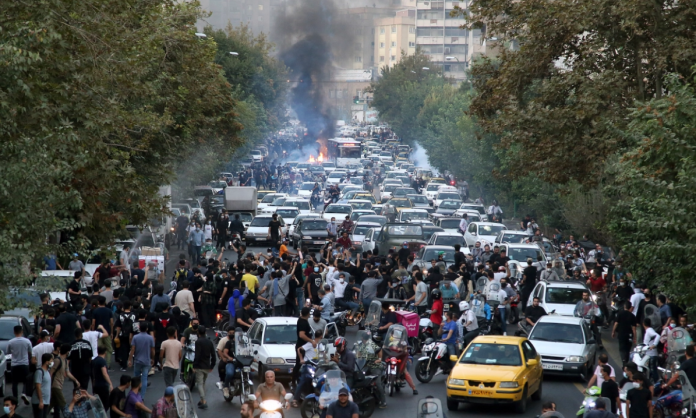Protests and riots have spread across Iran after a 22-year-old Kurdish woman, Mahsa Amini, was murdered by the morality police. Amini was visiting the capital, Tehran, on 13 September when she was arrested for allegedly breaking mandatory veiling laws. Police beat her into a coma and she died three days later. Amini was buried in her hometown of Saqqez.
What began as a funeral quickly turned into a protest. Hundreds of people marched on the streets chanting anti-regime slogans and women confronted security forces with headscarves in their hands. Protests have since spread across 100 cities and 30 provinces. From Tehran to the small island of Kish, workers, students, the young and the old are protesting in their thousands. Everywhere, people chant “We are all Mahsa!” and “Death to the Islamic republic!”
The Iranian government is facing a crisis of legitimacy as the economy continues to deteriorate under the burden of rising inflation, Western sanctions and the effects of COVID-19. The worsening economic conditions have led to an upturn in industrial struggle and protests in recent years, but each wave of resistance has been violently put down by the authorities.
While the unemployment rate continues to rise and almost one-third of the population lives in abject poverty, the ruling class continues to spend billions of dollars on the armed forces. When hard-line conservative Ebrahim Raisi gained the presidency in the 2021 election, voter turnout was the lowest in more than 40 years. Since then, the government has only become more unpopular as Raisi has introduced austerity measures, cracked down on organised labour and curtailed women’s rights.
In Iran, women are second-class citizens. They make up the poorest 10 percent of society and are brutalised by the morality police, which was created in 2005 to enforce mandatory hijab and modesty laws in public. Every year, the morality police prosecute more than 16,000 women and often abuse them verbally, physically and sexually.
As a conservative hardliner, Raisi came to power promising stability for the capitalist class. He ramped up the existing ideological offensive against women and ethnic and religious minorities. The regime banned access to basic birth control, and a new hijab and chastity law gave bosses with the right to fire women workers for dressing “improperly”. The state also increased the public surveillance of women, using facial recognition technology to identify and prosecute those breaking the modesty laws.
Protests over the murder of Amini began in the Kurdistan province. The Kurdish ethnic minority is persecuted in Iran, and Kurdish women face horrific sexual abuse at the hands of the country’s military and police forces. As a result, the province has been a hotbed of resistance to the state.
When police descended on protesters at Amini’s funeral, deploying tear gas and live ammunition, women and men began fighting back. They were brutally suppressed, but continued to protest after a group of Kurdish opposition parties called a marketers’ strike that shut down businesses across the province on Monday 19 September.
The scenes of defiance in Saqqez ignited protests across the country. In Tehran, thousands of university students took to the streets chanting, “Women, life, freedom!”, echoing the popular slogan from the 2018 protests: “Bread, jobs, freedom!” The regime mobilised the Basij—a paramilitary volunteer unit of the Islamic Revolutionary Guards—to crush the students, but this only inflamed their anger. Chants of “Death to Basij!” during Monday’s protests became burning the national flag on Tuesday and torching police vehicles on Wednesday.
Thousands of people across the country marched day and night. In Hamedan and Mashhad protesters set fire to police compounds, occupied intersections and built barricades. Women in many cities burned their hijabs in crowds of thousands, chanting: “If we don’t stand together, we will die one by one!”
The government mobilised riot cops and the military to crush the protests. Reports estimate that more than 30 people have been killed so far.
The movement has produced the largest mobilisation since the nationwide revolt in 2019. Spread across almost all the country’s provinces, the demonstrations are bigger than the 2018 Girls of Revolution Avenue protests and the 2020 #MeToo movement. The struggle has also involved young male students on a scale not seen before. Scenes of hundreds of men forming human chains to defend women burning their hijabs have gone viral on social media.
Students have emerged as a leading layer in the movement, with fourteen student organisations jointly issuing a set of demands on the government. These include dissolving the morality police, legislating the right to abortion and equal pay for women, and abolishing sexist family laws that shackle women to the home. Notably, students have called on workers to join the movement, arguing that women’s oppression must be fought from “the shop floor ... [to] the hospitals and universities ... to the kitchens in our homes”.
Sections of the labour movement have welcomed the student’s call to action. Militant sugarcane workers of the Haft Tappeh union and some teachers and retirees in Khuzestan, in the south-west, have organised protests across the province. Haft Tappeh workers remarked in a solidarity statement: “Basijis also came to destroy our strikes ... Students and workers must push back with force ... our victory is ours because we are united”.
The sugarcane workers argue that the movement must overcome the divide-and-rule strategy of the ruling class and unite in struggle against Iranian capitalism. For the movement to begin mounting a serious challenge to the state, workers must lead coordinated strike action.
Mahsa Amini’s murder has sparked another nationwide rebellion against the despotic Iranian regime. It remains to be seen if the protests will survive the current onslaught of state repression. But the transformative nature of the struggle is clear. As one student remarked, “Despite the batons, bullets and arrests, the streets have become happier”.










